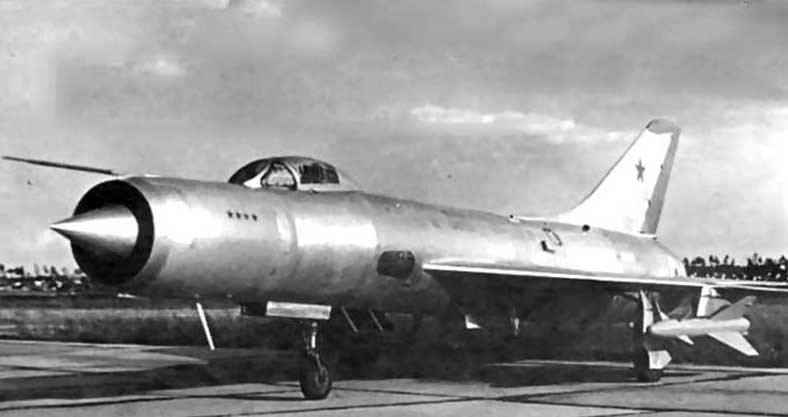The Sukhoi Su-11 (Fishpot-C) is a Soviet interceptor aircraft, an upgraded Su-9 with enhanced radar, armament, and engine capabilities.
In Brief
The Sukhoi Su-11, codenamed “Fishpot-C” by NATO, was a single-seat interceptor developed in the Soviet Union as an advanced version of the Su-9 (Fishpot-B). Introduced in the early 1960s, it featured a more powerful Lyulka AL-7F-1 turbojet engine, an improved RP-11 Oryol-D radar, and was armed with R-98 (AA-3 ‘Anab’) air-to-air missiles. Designed primarily for high-altitude interception, the Su-11 was equipped with a pressurized cockpit and an ejection seat, but lacked maneuverability and had limited range. It served as a key component of the USSR’s air defense system during the Cold War, although it was eventually supplanted by more advanced aircraft.
The Sukhoi Su-11 (Fishpot-C) stands out as a significant development in the lineage of Soviet interceptor aircraft, designed to enhance the air defense capabilities of the USSR during the tense period of the Cold War.
History of the Development of the Sukhoi Su-11 (Fishpot-C)
The development of the Su-11 was a response to the evolving needs of the Soviet Union’s air defense forces in the late 1950s and early 1960s. The era was marked by rapid advancements in reconnaissance and bomber aircraft, necessitating a robust interceptor that could engage high-altitude threats effectively. The Sukhoi Design Bureau, building on the experience gained from the Su-9 (Fishpot-B), initiated the Su-11 project to address the limitations encountered in its predecessor, especially in terms of radar and armament capabilities.
Launched in the early 1960s, the program aimed to create an interceptor with superior performance, including enhanced speed, altitude reach, and improved radar and missile systems. The Su-11 first took to the skies on December 25, 1961, showcasing immediate improvements over the Su-9, particularly with its new radar and more powerful engine.
The NATO nickname “Fishpot-C” followed the tradition of assigning code names to Soviet aircraft, with the Su-11’s predecessor being the Su-9 “Fishpot-B.” This code-naming convention helped standardize the identification of enemy aircraft for NATO pilots and analysts.
Design of the Sukhoi Su-11 (Fishpot-C)
The Su-11 was designed as an air superiority fighter with a focus on high-altitude interception. It was built around the powerful Lyulka AL-7F-1 turbojet engine, capable of propelling the aircraft to speeds of Mach 2.0. The aircraft featured a delta wing configuration, which was common in Soviet interceptors of the era, contributing to its high-altitude performance but at the expense of maneuverability and short-range efficiency.
Significant advancements were made in its avionics, most notably with the RP-11 Oryol-D (Eagle) radar, which offered improved target detection and tracking capabilities over its predecessor. The Su-11 was armed with two R-98 (AA-3 ‘Anab’) missiles, which were larger and more capable than the missiles used on the Su-9, providing the Su-11 with enhanced lethality.
One of the major design drawbacks was its limited operational range, a common limitation for interceptors of its time, which restricted its patrol endurance and operational flexibility. Additionally, while the aircraft had impressive speed and altitude performance, its heavy frame and engine configuration led to reduced maneuverability, a significant disadvantage in aerial combat situations.

Performance of the Sukhoi Su-11 (Fishpot-C)
The Su-11’s performance metrics were centered around its role as a high-altitude interceptor. Equipped with the Lyulka AL-7F-1 engine, it achieved a top speed of approximately Mach 2.0, with an operational ceiling above 18,000 meters (59,000 feet). This high-speed, high-altitude capability allowed it to intercept and engage enemy targets effectively before they could pose a threat to Soviet territory.
Comparatively, the Su-11 was a potent aircraft for its designated role, but when matched against Western counterparts like the American McDonnell Douglas F-4 Phantom II, it faced limitations in versatility, combat range, and pilot situational awareness. The Phantom II, with its two-man crew, superior radar, and greater payload flexibility, offered a more adaptable platform, though the Su-11 maintained advantages in specific high-altitude interception scenarios.
Variants of the Sukhoi Su-11 (Fishpot-C)
The primary version of the Su-11 was the initial production model, with no significant variants produced. However, there were proposals and design studies for upgraded versions featuring improved engines, avionics, and armament configurations, but these did not progress beyond the prototype or conceptual stages due to the rapid advancement in aviation technology and the shift towards third-generation fighter jets which offered multi-role capabilities and advanced beyond visual range engagement options.
Military Use and Combat of the Sukhoi Su-11 (Fishpot-C)
The Su-11 was deployed primarily within the Soviet Air Defense Forces, tasked with the high-altitude interception of reconnaissance aircraft, bombers, and spy balloons. While there are no well-documented instances of the Su-11 engaging in actual combat, its presence was a critical factor in the strategic air defense of the Soviet Union during the Cold War, deterring potential high-altitude intrusions.
The aircraft’s operational history was marked by its role in reinforcing the USSR’s air defense perimeter, ready to be scrambled in response to potential threats. Despite its designed capability, the lack of maneuverability and limited engagement envelope reduced its effectiveness in a rapidly evolving aerial threat environment, leading to its eventual replacement by more advanced aircraft like the MiG-23 and MiG-25.
The Sukhoi Su-11 (Fishpot-C) played a pivotal role in the evolution of Soviet air defense capabilities during a crucial period of the Cold War. As an interceptor, it embodied the technological ambitions and strategic imperatives of its time, offering valuable lessons in aircraft design, particularly in radar and missile technology. Despite its operational limitations and eventual obsolescence, the Su-11 contributed to the deterrence posture of the Soviet Union, underscoring the importance of air superiority in national defense strategy. Its legacy is reflected in the subsequent generations of Soviet and Russian fighter aircraft, which continued to prioritize speed, altitude, and the integration of advanced avionics and weaponry.
Back to the Fighter Jet section.